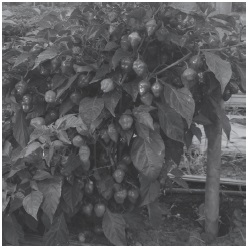Extraction of mineral nutrients in pepper (Capsicum sp.) leaves and fruits and its influence on yield

Abstract
Crop nutrition is a central axis in agricultural production; however, sometimes fertilizer additions do not correspond to the edaphic conditions of the area of cultivation or the requirements of the plants; this inadequate fertilization management induces soil degradation, decreased yield and high production costs. An alternative to soil conservation is the application of organic amendments, which increase the availability of nutrients and give rise to the recovery of soils. The aim of this study was to determine the effect on the growth and development of Phaseolus vulgaris var. Cerinza with the application of organic amendments (compost and vermicompost) and commercial fertilizer. Plant height, photosynthetic pigment content, number of leaves and reproductive structures, fresh and dry weight, leaf area, area under the canopy and growth indexes: specific leaf area (SLA), crop growth rate (CGR) and net assimilation rate (NAR) were evaluated. The results at 56 days after sowing showed significant differences in height, where the treatments of compost and vermicompost had higher values in relation to the commercial fertilization. In the other growth variables, there were no significant differences between the treatments.
Keywords
Capsicum frutescens, Capsicum chinense J., Efficient fertilization, Nutrients
Author Biography
Maria del Pilar Romero-Lozada
Ingeniero Agronomo. Estudiante de maestría universidad nacional de Colombia. Sede Palmira.
References
- Alejo, S.G., E.G. Luna, H.R. Sánchez, P.E. Salcedo, P.J.D. García y M.V.M. Jiménez. 2015. Determination of the nitrogen requirement for habanero pepper (Capsicum chinense Jacq.) México. Rev. Chapingo Serie Hortic. 21(3), 215-221. Doi: 10.5154/r.rchsh.2014.04.015
- Ayodele, O.J., E.O. Alabi y M. Aluko. 2015. Nitrogen fertilizer effects on growth, yield and chemical composition of hot pepper (Rodo). Int. J. Agr. Crop Sci. 8 (5), 666-673.
- Azofeifa A. y M.A. Moreira. 2005. Absorción y distribución de nutrimentos en plantas de chile dulce (Capsicum annuum CV. UCR 589) en Alajuela, Costa Rica. Agron. Costarr. 29(1), 77-84.
- Bosland, P.W. y E.J. Votaba. 2012. Pepper: Vegetable and spice capsicums. 2nd ed. CABI Publishing, Wallingford, UK. Doi: 10.1079/9781845938253.0000
- Buczkowska, H., Z. Michałojć, J. Konopińska y P. Kowalik. 2015. Content of macroand microelements in sweet pepper fruits depending on foliar feeding with calcium. J. Elem. 20(2), 261-272. Doi: 10.5601/jelem.2014.19.3.712
- Constantino M.R., A.J.D. Gómez, S.V. Álvarez, G.E, Huerta y E. Barba. 2008. Effect of inoculation with rhizobacteria and arbuscular mycorrhizal fungi on growth and yield of Capsicum chinense Jacquin. J. Agric. Rural Develop. Trop. Subtrop. 109, 169-180.
- García H.J.L., C.R. D. Valdez, V.R. Servín, D.E. Troyo, A.B. Murillo, P.E.O. Rueda, O.J.C. Rodríguez y Q.R. Magallanes. 2007. Interacciones nutrimentales y normas de diagnóstico de nutrimento compuesto en un cultivar semidomesticado de Capsicum frutescens. Rev. Chapingo Ser. Hortic. 13(2), 133-140. Doi: 10.5154/r.rchsh.2007.01.004
- Inzunza, I.M.A., V.C.M. Magdalena, V.E.A. Catalán y L.A. Román. 2010. Extracción de nutrientes y producción de chile jalapeño bajo acolchado plástico y niveles de riego. Terra Latinoam. 28(3), 211-218.
- Malavolta, E., G.C. Vitti y S.A. de Oliveira. 1997. Avaliação do estado nutricional de plantas: Princípios e aplicações. Potafos. 2a ed. Piracicaba, Brasil.
- Marschner, H. 1995. Mineral nutrition of higher plants. Academic Press. 2nd ed. London, UK.
- Mckean, S.J. 1993. Manual de análisis de suelos y tejido vegetal: una guía teórica y práctica de metodologías. Documento de trabajo No.129. Laboratorio de Servicios Analíticos. Centro Internacional de Agricultura Tropical (CIAT). Cali, Colombia.
- Nieves, G.F., S.G. Alejo, E.G. Luna, F.C. Lemus, L.P. Juárez y P.E. Salcedo. 2015. Extracción y requerimiento de fósforo en chile habanero (Capsicum chinense Jacq.) ’Big Brother’. Interciencia 40(4), 282-286.
- Noh, M.J., G.L. Borges y F.M. Soria. 2010. Composición nutrimental de biomasa y tejidos conductores en chile habanero (Capsicum chinense Jacq.). Trop. Subtrop. Agroecosyst. 12, 219-228.
- Ortas, I. 2013. Influences of nitrogen and potassium fertilizer rates on pepper and tomato yield and nutrient uptake under field conditions. Sci. Res. Essays. 8(23), 1048-1055. Doi: 10.5897/SRE11.579
- Pardey, R.K., D.M.A. García y C.F.A. Vallejo. 2009. Evaluación agronómica de accesiones de Capsicum del banco de germoplasma de la Universidad Nacional de Colombia, sede Palmira. Acta Agron. 58(1), 23-28.
- Puentes, P.Y.J., F.J.C. Menjivar y H.F. Aranzazu. 2016. Concentración de nutrientes en hojas, una herramienta para el diagnóstico nutricional en cacao. Costa Rica. Agron. Mesoam. 27(2), 329-336. Doi: 10.15517/am.v27i2.19728
- Quintal, O.W.C., G.A. Pérez, M.L. Latournerie, L.C. May, S.E. Ruiz y C.A.J. Martínez. 2012. Uso de agua, potencial hídrico y rendimiento de chile habanero (Capsicum chinense Jacq.). Rev. Fitotec. Mex. 35 (2), 155-160.
- Reyes, R.A., A.M. López, S.E. Ruiz, M.L. Latournerie, G.A. Pérez, C.M.G. Lozano y L.M.J. Zavala. 2014. Efectividad de inoculantes microbianos en el crecimiento y productividad de chile habanero (Capsicum chinense Jacq.). Agrociencia 48, 285-294.
- Romero, L.M.P., P.Y.J. Puentes y F.J.C. Menjivar. 2016. Eficiencia de uso de nutrientes en ají tabasco (Capsicum frutescens L.) y habanero (Capsicum chinense Jacq). Rev. Investig. Agr. Ambient. 7(2), 121-127. Doi: 10.22490/21456453.1562
- Salazar, J.F.I. y L.P. Juárez. 2013. Requerimiento macronutrimental en plantas de chile (Capsicum annuum L.). Rev. BioCiencias 2(2), 27-34.
- Salisbury, F. B. y Ross, C.W. 2000. Fisiología de las plantas. Ed. Paraninfo Thomson Learning, Madrid, España.
- Vallejo, C.F.A. y S.E.I. Estrada. 2004. Producción de hortalizas de clima cálido. Universidad Nacional de Colombia. Palmira, Colombia.
- Zayed, M.S., M.K.K. Hassanein, H.E. Nahed y M.M.F. Abdallah. 2013. Productivity of pepper crop (Capsicum annuum L.). as affected by organic fertilizer, soil solarization, and endomycorrhizae. Ann. Agric. Sci. 58(2), 131-137. Doi: 10.1016/j.aoas.2013.07.011
